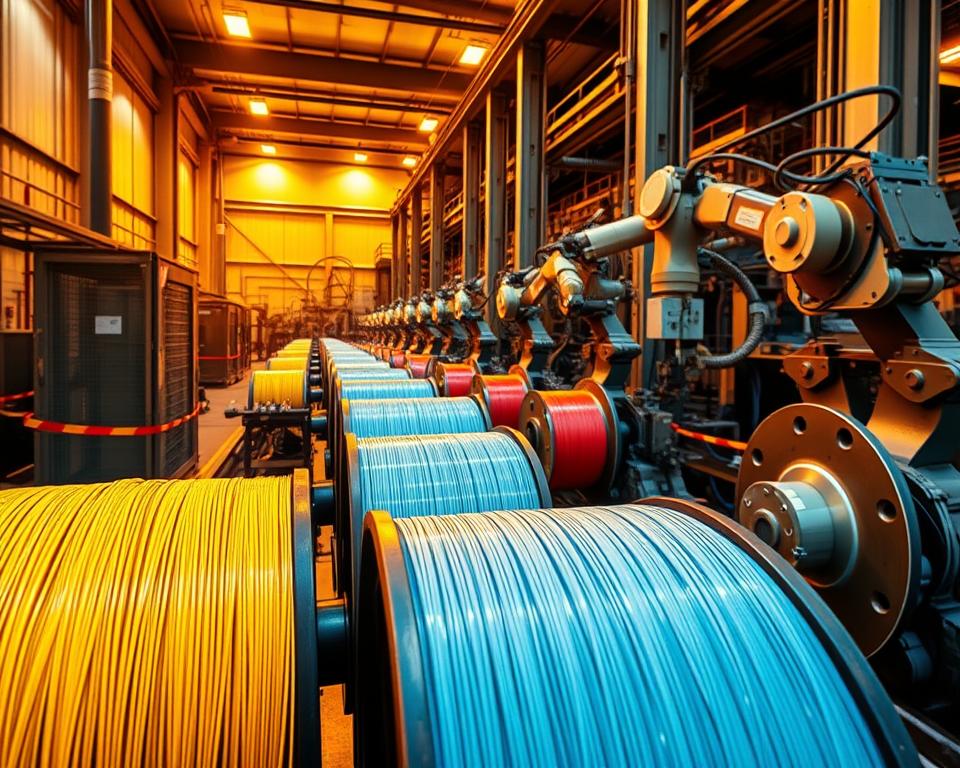Potassium Silicate Facts: Fundamental Uses & Benefits
Potassium silicate has been a pillar in multiple industries for over a century, yet its vast potential remains underappreciated. This substance is critical in sectors from construction to agriculture, highlighting its key roles and advantages. We will explore the captivating realm of potassium silicate, also known as K silicate, to grasp its significance in contemporary deployments.
Investigating K silicate facts reveals its noteworthy impact on material enhancement and eco-friendliness. It’s essential for experts in construction, environmental advocates, and persons intrigued by innovative materials. This article intends to highlight the substantial role of K silicate in our world.
Key Points
- Potassium silicate plays a crucial role in the construction industry for its resilience.
- This compound is valued for its eco-friendly features and safety features.
- K silicate enhances waterproofing and ventilation in building materials.
- Its deployments transcend construction into niches like agriculture and industrial coatings.
- Familiarity with K silicate can enhance consumer selections in sustainable products.
Overview to K Silicate
K silicate, or potassium silicate, is a compound formed by combining silica and potassium oxide. This mixture renders it essential in numerous industries due to its wide-ranging properties. It is commonly used as a binding agent in many materials.
Key features of K silicate include its water resistance and durability. These qualities prolong the life of construction materials but also secure their structural integrity. Its deployments extend beyond construction, reaching into agriculture and household products.
With a increasing attention on sustainability, potassium silicate is becoming prominent for its green qualities. It allows industries to reduce their environmental footprint while preserving material strength and resilience. Thus, it’s a practical and sustainable choice.
| Attribute | Description |
|---|---|
| Chemical Composition | Silica (SiO2) and Potassium Oxide (K2O) |
| Water Resistance | Very effective in moisture barrier deployments |
| Durability | Increases longevity of construction materials |
| Environmental Impact | Promotes sustainable approaches |
What is Potassium Silicate?
Potassium silicate is an mineral-based compound celebrated for its multiple applications and chemical properties. It is described as a combination of potassium oxide (K2O) and silica (SiO2). This combination creates a unique adhesive essential across diverse industries.
The K silicate chemical composition includes about 30% potassium oxide and 70% silica. This proportion gives potassium silicate its defining structure. It renders the material suitable for use in fertilizers, fireproofing materials, and paints.
Understanding the potassium silicate formula is essential for grasping its significance in industrial processes. The formula, K2SiO3, highlights its stable and trustworthy chemical structure.
- Incredibly effective as a binder in construction materials.
- Employed as an adhesive in manufacturing processes.
- Enhances improved water retention in agricultural applications.
Potassium silicate’s versatility derives from its existence in both liquid and solid forms. This versatility meets specific demands across diverse sectors. In agriculture, it is pivotal by improving nutrient availability and improving soil quality, thus promoting healthier plant growth.
| Property | Characteristics |
|---|---|
| Potassium Oxide Content | 30% |
| Silica Content | 70% |
| Common Applications | Agriculture, Coatings, Fireproofing |
| Forms | Liquid, Solid |
History and Development of K Silicate
In 1768, the German poet and scientist J.W. Goethe discovered potassium silicate. This discovery set the stage for understanding its chemical structure and potential uses. The 19th century saw major advancements, spearheaded by German scientist Georg Friedrich Keim. He invented silicate paints, starting practical uses in the coating industry.
Throughout its history, potassium silicate has been employed in construction and agriculture. Initially, it was used to enhance material durability and protect surfaces from environmental damage. Its versatility expanded over time, enabling it to enter various industries like ceramics and textiles.
The 20th century brought further development, thanks to material science developments. Researchers created new formulations that boosted bonding and weather resistance. These innovations broadened its use across industries. Today, potassium silicate’s historical deployments underscore its persistent importance in industrial processes and sustainable construction.
| Era | Significant Development | Applications |
|---|---|---|
| 1768 | Discovery by J.W. Goethe | Foundation for chemical grasp |
| 19th Century | Creation by Georg Friedrich Keim | Silicate paints and coatings |
| 20th Century | Improvements in material science | Construction, agriculture, textiles |
Environmental Impact of Potassium Silicate
Potassium silicate is distinguished as a essential element in the green materials sector. Its small green footprint sets apart it from standard organic coatings, which can emit harmful substances. By adopting potassium silicate, industries encourage sustainable practices and guarantee structures have greater longevity.
The eco-friendliness of potassium silicate is supported by multiple critical factors:
- Non-toxic makeup, making it safer for both users and end-users.
- Biodegradable characteristics that lessen long-term environmental harm.
- Enhanced breathability in building applications, which helps regulate indoor air quality.
Potassium silicate’s use in green building materials significantly cuts down on environmental pollution from traditional coatings. Its part in sustainable architecture is key, fulfilling the modern need for eco-friendly construction. Builders get substantial merits in performance and environmental responsibility with this product.
| Feature | Potassium Silicate | Conventional Organic Coatings |
|---|---|---|
| Toxicity | Non-toxic | Dangerous by-products |
| Environmental Impact | Low | High |
| Biodegradability | Biodegradable | Non-degradable |
| Indoor Air Quality | Improves | Can deteriorate |
Inorganic Coatings vs. Organic Coatings
The decision between inorganic and organic coatings is crucial in construction and manufacturing. Inorganic coatings stand out for their durability and environmental safety. They provide unique merits that cause them to be a preferred choice in many uses.
Inorganic coatings, often sourced from minerals like potassium silicate, shine in resisting water and functioning effectively in tough conditions. Their antimicrobial characteristics improve hygiene and extend the life of surfaces. This causes them to be optimal for spaces with heavy use.
Organic coatings, alternatively, are carbon-based and capable in many circumstances. However, they might not last as long as inorganic coatings and can demand more upkeep. This could cause higher costs over time.
| Property | Inorganic Coatings | Organic Coatings |
|---|---|---|
| Durability | High resistance to wear and tear | Moderate, varies based on formulation |
| Water Resistance | Excellent | Varies, some susceptible to harm |
| Antibacterial Properties | Present | Limited |
| Environmental Impact | Lower toxicity, safer for prolonged use | Higher volatile organic compounds (VOCs) |
| Longevity | Long-lasting, requires less often reapplication | Reduced longevity, higher upkeep expenses |
Inorganic coatings are a preferred option for many uses, providing superior performance and environmental benefits. They demand less maintenance, making them a practical option. The right coating can profoundly influence a project’s durability and sustainability. It’s key to understand these differences for better decision-making.
K Silicate: Regular Uses in Construction
Potassium silicate is becoming ever more vital in the construction sector for its varied uses. Its distinct characteristics make it ideal for various tasks, particularly in paints and coatings and as a component in building materials. This substance is appreciated for its potential to improve durability and sustainability in construction projects, offering substantial benefits.
Applications in Paints and Coatings
Potassium silicate is crucial in the production of paints and coatings. It guarantees excellent adhesion and shields surfaces against environmental elements, causing it to be key for several industries:
- Mineral paints employ potassium silicate for its durability and breathability.
- Commercial coatings include potassium silicate to improve their performance against weathering.
- Interior paints use its binding properties for a smooth, enduring finish.
Structural Benefits in Building Materials
Integrating potassium silicate into building materials greatly boosts structural integrity. This compound strengthens concrete and masonry, providing numerous advantages:
- It boosts resistance to cracking and wear.
- It enhances water resistance, guarding against moisture damage.
- It improves thermal insulation, decreasing energy costs.
The use of potassium silicate in construction underscores its critical role in creating advanced materials and technologies. These encourage eco-friendly practices within the industry.
| Application | Benefits | Examples |
|---|---|---|
| Paints and Coatings | Strength, adhesion, weather resistance | Mineral paints, commercial roof coatings |
| Building Materials | Robustness, moisture resistance, thermal insulation | Concrete, masonry products |
Potassium Silicate Benefits
Potassium silicate offers numerous advantages, rendering it vital in various sectors. Its health benefits and eco-friendliness emphasize its potential for broader use across industries.
Wellness and Protection Benefits
Its non-toxic nature is a major advantage of potassium silicate. This guarantees it’s safe for indoor settings, boosting air quality and preventing health hazards. Moreover, it has low VOC emissions, a attribute that is consistent with current market trends. Consumers progressively seek products that focus on health and safety.
Environmental Friendliness
Potassium silicate’s organic makeup causes it to be environmentally friendly. It demands less energy to create than synthetic options, reducing its environmental impact. As sustainable building practices increase, potassium silicate’s attraction rises. It promotes efforts to decrease environmental harm, attracting eco-aware builders and consumers.
| Feature | Potassium Silicate | Synthetic Alternatives |
|---|---|---|
| Toxicity | Non-toxic | Potentially harmful |
| VOC Emissions | Low | High |
| Energy Efficiency in Production | Lower energy consumption | Higher energy consumption |
| Eco-friendliness | Yes | Varies |
Potassium Silicate Deployments in Industry
Potassium silicate is essential in various industrial sectors. It is a major player in ceramics, agriculture, and manufacturing. Its impact is evident in improving product quality and durability.
In ceramics, potassium silicate improves strength and thermal resistance. This causes ceramic products stronger across a wide spectrum of applications.
In agriculture, K silicate improves soil structure and nutrient availability. It helps in plant growth, allowing farmers boost crop yields and protect against pests.
The manufacturing industry is reliant on potassium silicate for its binding properties. It’s used in making adhesives, sealants, and coatings. These products are recognized for their durability, essential for industrial deployments.
Potassium silicate’s capacity to strengthen materials and enhance thermal stability makes it a top choice for industries seeking quality and reliability. As innovation progresses, its deployments are likely to expand, unveiling new possibilities across sectors.
Fireproofing and Safety Attributes
Potassium silicate demonstrates extraordinary fire resistance, capable of withstanding temperatures up to 1300℃. Its high heat tolerance renders it essential in construction and manufacturing sectors, where flammability is a significant concern.
The flame retardant nature of potassium silicate improves safety in building materials and structures. It stops combustion, serving as a protective barrier against fire hazards. This is key in environments where fire safety compliance is required.
- Prevents ignition, offering additional protection in case of a fire.
- Preserves integrity under extreme temperatures, preventing structural failure.
- Limits the spread of flames, allowing more time for evacuation and response.
Incorporating potassium silicate into coatings and materials improves their fire-resistant capabilities. By integrating these safety properties in building projects, it doesn’t just complies with regulatory standards but also improves overall safety for people and assets.
Water-Resistance and Breathability of K Silicate
Water resistance and breathability are crucial features of potassium silicate in construction. Its distinct chemical composition secures it prevents water entry while allowing moisture to evaporate. This balance is key for the durability of building materials.
Applying potassium silicate as a coating safeguards surfaces from water damage. It lessens the risk of mold and mildew, which can harm indoor air quality and building structure. By being breathable, potassium silicate supports optimal wall performance, enhancing indoor health.
Using potassium silicate in building materials provides major advantages in controlling humidity. It’s notably beneficial in regions susceptible to high humidity or regular moisture. Here are the main benefits of potassium silicate for water resistance and breathability:
- Minimizes moisture buildup and promotes air circulation
- Prevents water from entering surfaces
- Boosts the durability of coatings and finishes
- Supports energy efficiency in buildings
| Feature | Benefit |
|---|---|
| Moisture Resistance | Blocks water damage and deterioration of materials |
| Airflow | Allows moisture to escape, lessening mold risk |
| Resilience | Enhances longevity of coatings and structures |
| Insulation Efficiency | Decreases heating and cooling costs through better insulation |
Optimal moisture management with potassium silicate properties boosts the performance and lifespan of construction materials. Adopting these benefits causes healthier environments and more resilient structures.
Climate Durability Features of Potassium Silicate
Potassium silicate coatings display superior weather resistance, rendering them perfect for outdoor use. They are able to endure rain, snow, and UV radiation, unlike traditional organic coatings. Their durability under tough weather conditions sets them apart.
One major benefit of potassium silicate is its outstanding adhesion and moisture resistance. This ensures the coating doesn’t deteriorate over time, differently from other materials exposed to moisture. The result is a protective layer that blocks water and boosts the structure’s longevity.
Moreover, these coatings retain their color vibrancy, even under intense sunlight. This feature causes them to be optimal for outdoor settings where aesthetic is crucial. Both homeowners and builders value their durability and aesthetic appeal.
| Feature | Potassium Silicate | Traditional Organic Coatings |
|---|---|---|
| Weather Resistance | Excellent; endures rain, snow, and UV exposure | Moderate; vulnerable to fading and degradation |
| Moisture Resistance | High; strong adhesion and limited water penetration | Low to Moderate; susceptible to water damage |
| Longevity | Long-lasting; maintains integrity across diverse climates | Shorter lifespan; requires frequent maintenance |
| Color Retention | High; resists fading over time | Low; color might fade quickly in sunlight |
Potassium silicate is rising in popularity in modern construction for its sustainability and durability. This material doesn’t merely enhances building performance but also boosts their visual appeal.
Key Potassium Silicate Formula and Composition
The potassium silicate formula is remarkable for its composition, mainly silicon dioxide (SiO2) and potassium oxide (K2O). These elements merge to establish a material with distinct properties. These properties make it ideal for multiple industrial applications.
This substance’s chemical structure permits it to act as a binder. It fortifies and durability to materials. Its features comprise resistance to water, high thermal stability, and superior adhesion. These features make potassium silicate essential in construction, agriculture, and manufacturing sectors.
| Component | Function | Properties |
|---|---|---|
| Silicon Dioxide (SiO2) | Forms the backbone of the structure | Provides stability and durability |
| Potassium Oxide (K2O) | Improves bonding capabilities | Boosts water resistance |
| Water | Fluid base | Aids in use |
Grasping the potassium silicate formula and its chemical makeup is crucial to utilizing its full potential. Its special properties cause it to be a go-to solution for specialists globally. It is notable for its effectiveness across varied industries.
Raising Consumer Awareness and Informed Choices
Raising knowledge about potassium silicate products is vital to encouraging sustainable and safe building material choices. By understanding the benefits of K silicate, consumers can take selections that benefit their projects and the environment.
Potassium silicate is adaptable, notably in paints and coatings. It offers advantages like increased durability, fire resistance, and eco-friendliness. Yet, misconceptions about its use are frequent, underscoring the need for consumer education on its properties and benefits.
- Value of grasping the components of potassium silicate products
- Recognizing manufacturers committed to sustainable practices
- Assessing the performance characteristics of K silicate in real-world applications
By focusing on these areas, consumers can make knowledgeable decisions. This strategy doesn’t just causes better choices but also encourages the use of eco-friendly alternatives in construction and renovation.
| Feature | Potassium Silicate Products | Standard Options |
|---|---|---|
| Green Credentials | Low impact; natural mineral | Higher impact; synthetic chemicals |
| Durability | Long-lasting; moisture-resistant | Variable; might need more frequent applications |
| Fire Resistance | Highly fire-resistant | Often flammable |
| Application Simplicity | Easy to apply; versatile | Might require specific conditions for proper application |
Understanding potassium silicate products helps with making eco-aware purchasing decisions. When consumers select informed choices, they create a market for safer, sustainable building materials.
In Summary
The summary on potassium silicate emphasizes its vital significance and broad deployments across industries. It’s a key element for sustainable growth. Its role in improving construction material durability and offering environmental benefits is undeniable. K silicate is distinguished as a crucial asset in a market that’s progressively shifting.
Looking ahead, the future of K silicate looks bright with ongoing innovation. Expanding interest in potassium silicate among industries indicates a shift towards sustainable product development. Its strong properties render it a top choice for manufacturers aiming to boost their products and support environmental goals.
In closing this discussion, it’s evident that potassium silicate will remain essential for progressing sustainable practices. Its extensive uses doesn’t merely enhance product performance but also promote environmentally conscious solutions. This focus to K silicate use is vital in our quest for a sustainable future.



